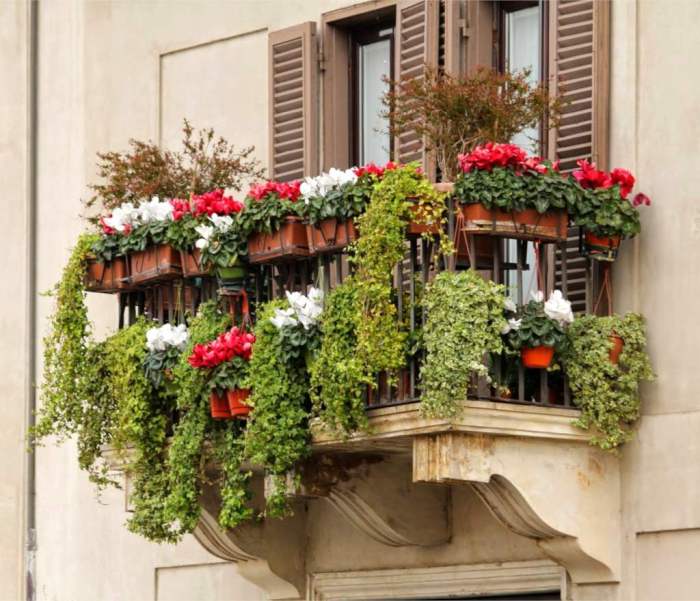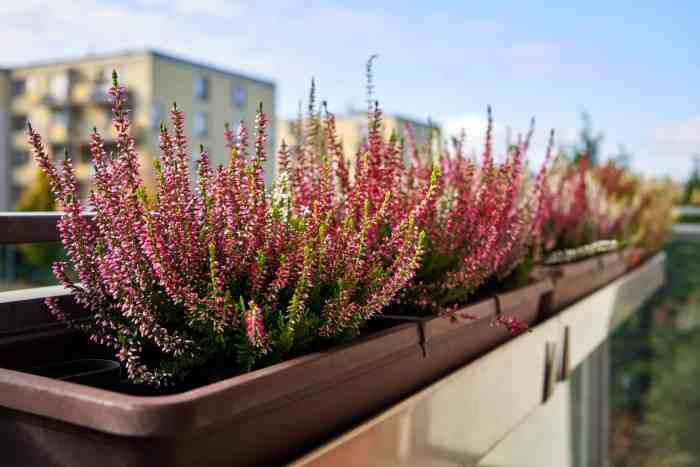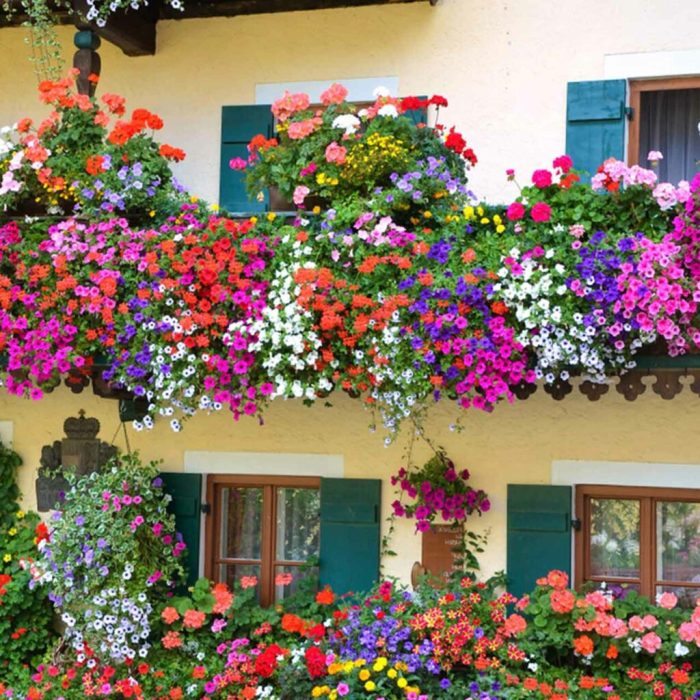Transform your sunny balcony into a vibrant and thriving outdoor oasis with our comprehensive guide to the best plants for sunny balconies. Whether you’re a seasoned gardener or a novice looking to add a touch of greenery to your urban space, this article will provide you with all the essential information you need to create a flourishing balcony garden.
From choosing the perfect plants to designing a stunning arrangement, we’ll cover everything you need to know to create a balcony garden that will bring you joy and beauty for seasons to come.
Top Plant Options for Abundant Sunlight
Sunny balconies offer an ideal environment for a wide range of vibrant and flourishing plants. To help you create a thriving outdoor oasis, here’s a comprehensive list of top plant options that thrive in ample sunlight:
- Petunias( Petunia × hybrida): These cheerful annuals boast a profusion of trumpet-shaped blooms in a kaleidoscope of colors. They prefer well-drained soil and regular watering.
- Marigolds( Tagetes spp.): Known for their vibrant orange and yellow hues, marigolds are excellent pest repellents. They require full sun and well-drained soil.
- Zinnias( Zinnia elegans): With their daisy-like blooms in bold colors, zinnias are a popular choice for sunny balconies. They prefer fertile, well-drained soil and regular watering.
- Geraniums( Pelargonium spp.): These versatile plants offer a range of flower colors and foliage textures. They prefer well-drained soil and moderate watering.
- Portulaca( Portulaca grandiflora): Also known as moss rose, portulaca produces colorful, succulent-like flowers that thrive in hot, dry conditions.
- Lantana( Lantana camara): This heat-tolerant shrub offers clusters of fragrant flowers in vibrant hues. It requires well-drained soil and regular watering.
- Hibiscus( Hibiscus spp.): With their large, showy flowers in a range of colors, hibiscus plants add a tropical touch to sunny balconies. They prefer well-drained soil and regular watering.
- Bougainvillea( Bougainvillea spp.): This vigorous vine produces colorful bracts that resemble flowers. It requires well-drained soil and regular watering.
Creating a Thriving Balcony Garden

Establishing a thriving balcony garden requires careful planning and attention to essential elements. Container selection is crucial, with materials like terracotta, plastic, or fabric pots offering different advantages and drawbacks. Soil preparation involves selecting a well-draining potting mix tailored to the specific plant species being grown.
Regular fertilization provides essential nutrients for healthy growth.
Maximizing Space Utilization
Optimizing balcony space is key. Plant spacing should allow for adequate airflow and prevent overcrowding. Companion planting, where compatible species are grown together for mutual benefits, can enhance growth and deter pests. Vertical gardening techniques, such as trellises or hanging baskets, utilize vertical space effectively.
For those seeking to add greenery to their sunny balconies, consider the vibrant blooms of geraniums or the cascading foliage of petunias. To create a hanging garden indoors, explore options such as best plants to hang indoors like the trailing pothos or the elegant string of pearls.
Back on the balcony, incorporate the cheerful blooms of impatiens or the architectural interest of lavender to complete your sunny oasis.
Regular Maintenance
Regular watering is vital, especially during hot and dry weather. Overwatering should be avoided, as it can lead to root rot. Pest control measures, such as neem oil or insecticidal soap, are crucial to prevent infestations. Seasonal maintenance involves pruning, deadheading, and repotting as needed to ensure optimal plant growth throughout the year.
Designing a Balcony Oasis
Creating a beautiful and functional balcony garden requires careful planning and design. By considering factors such as color schemes, plant textures, and vertical arrangements, you can create a vibrant and inviting outdoor space.
While selecting the best plants for your sunny balconies, consider the citronella plant, lavender, or rosemary, which not only thrive in sunlight but also effectively repel insects. For a more comprehensive guide on bug-repelling plants, refer to our article on the best plants for keeping bugs away . This resource provides valuable insights into choosing the right plants for your sunny balcony, ensuring a bug-free and vibrant outdoor space.
Creating Privacy and Windbreaks
If your balcony is exposed to prying eyes or strong winds, consider using plants to create privacy screens and windbreaks. Tall, bushy plants like bamboo or evergreen shrubs can provide effective barriers. Trellises covered with climbing plants can also create a sense of enclosure and shelter from the wind.
Incorporating Seating Areas
To make your balcony more inviting, incorporate comfortable seating areas. Choose weather-resistant furniture that can withstand the elements. Consider adding cushions or throws for added comfort. Position your seating to maximize sunlight and views.
Using Trellises and Hanging Baskets, Best plants for sunny balconies
Trellises and hanging baskets can enhance the visual appeal and functionality of your balcony garden. Trellises provide support for climbing plants, creating vertical interest and saving space. Hanging baskets can accommodate plants that prefer to trail or cascade, adding a touch of elegance to your balcony.
Balcony Gardening for Different Climates

Balcony gardening offers a unique opportunity to cultivate plants in urban environments. However, selecting the right plants for your balcony depends on the specific climate zone in which you reside.
Factors such as temperature, humidity, and rainfall play a crucial role in determining which plants will thrive on your balcony. Understanding the microclimate of your balcony and choosing plants that are well-suited to those conditions is essential for a successful balcony garden.
When selecting the best plants for your sunny balcony, consider varieties that thrive in bright sunlight. These may include vibrant succulents, fragrant herbs, or colorful flowering plants. For those with humid bathrooms, there are also specific plants that flourish in such environments.
Explore the best plants for humid bathroom to create a lush oasis in your shower space. Returning to the topic of sunny balconies, hardy succulents like aloe vera and echeveria are excellent choices for their resilience and low-maintenance nature, adding a touch of greenery to your outdoor living area.
Hot, Dry Climates
In hot, dry climates, plants that are drought-tolerant and can withstand intense sunlight are ideal for balconies. Some excellent options include:
- Succulents, such as aloe vera, echeveria, and sedum, are known for their ability to store water in their thick, fleshy leaves.
- Cacti, such as the popular prickly pear cactus, are also well-suited to hot, dry conditions.
- Herbs, such as rosemary, thyme, and oregano, can also tolerate these conditions and add a touch of flavor to your balcony garden.
Cooler Temperatures and Higher Humidity
In climates with cooler temperatures and higher humidity, plants that prefer moist soil and can tolerate shade or partial shade are more suitable for balconies. Some good choices include:
- Ferns, such as the maidenhair fern and the Boston fern, thrive in humid environments and can add a touch of greenery to your balcony.
- Hostas, with their large, showy leaves, are also tolerant of shade and can add a dramatic touch to your balcony.
- Begonias, with their colorful blooms, are another excellent option for balconies with cooler temperatures and higher humidity.
Plant Care and Troubleshooting

Balcony gardening offers a unique set of challenges, including pests, diseases, and nutrient deficiencies. By understanding these common issues and adopting practical solutions, you can maintain healthy plants and prevent problems from escalating.
Identifying and Resolving Common Issues
Regular observation and monitoring are crucial for early detection and prompt treatment of plant health problems. Pests can be identified by their physical presence or damage to leaves, stems, or flowers. Diseases may manifest as spots, discoloration, or wilting. Nutrient deficiencies can be identified by specific symptoms, such as yellowing leaves or stunted growth.Organic
pest control methods include insecticidal soap, neem oil, and companion planting. Natural remedies for diseases include baking soda solutions, copper fungicides, and garlic spray. Nutrient deficiencies can be addressed by using organic fertilizers or soil amendments tailored to specific plant needs.
Summary

With careful planning and a bit of TLC, you can transform your sunny balcony into a flourishing outdoor haven that will provide you with years of enjoyment. So, gather your gardening tools, choose your favorite plants, and let’s get started on creating your dream balcony oasis.
Essential Questionnaire: Best Plants For Sunny Balconies
What are the best plants for a sunny balcony that blooms all year round?
Some great options include geraniums, petunias, lantana, and verbena.
How often should I water my balcony plants?
The frequency of watering will depend on the specific plants you choose, but a good rule of thumb is to water when the soil feels dry to the touch.
What are some tips for creating a privacy screen on my balcony?
Tall plants like bamboo or climbing vines like ivy can be used to create a natural privacy screen on your balcony.